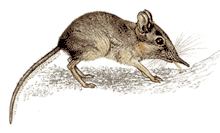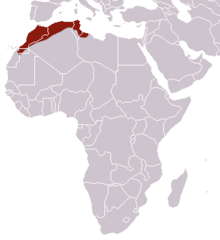North African elephant shrew
| North African elephant shrew[1] | |
|---|---|
 | |
| Scientific classification | |
| Kingdom: | Animalia |
| Phylum: | Chordata |
| Class: | Mammalia |
| Order: | Macroscelidea |
| Family: | Macroscelididae |
| Genus: | Petrosaltator |
| Species: | P. rozeti |
| Binomial name | |
| Petrosaltator rozeti (Duvernoy, 1833) | |
 | |
| North African elephant shrew range | |
| Synonyms[3] | |
|
Macroscelides rozeti Duvernoy, 1833 | |
The North African elephant shrew or North African sengi (Petrosaltator rozeti) is a species of elephant shrew in the family Macroscelididae. It is found in Algeria, Libya, Morocco, and Tunisia, and is the only extant afrotherian within its range. Recent phylogenetic analyses suggest that its status as the only extant member of its order north of the Sahara has resulted in a genetic split from the other Macroscelididae species. This split likely occurred during the Miocene period.[4] In 2016, John Dumbacher and colleagues created a new genus, Petrosaltator, for this species, recombining the scientific name to Petrosaltator rozeti.[5]
Description
The North African elephant-shrew is a little rodent-like in appearance, having a small body, large ears, and a long tail. It weighs around 50g, which is very light compared to other sengis). The total length is from 24 to 38.5 cm, of which the tail is 13 to 16 cm. The fur on the upper body varies from yellowish brown to pale sandy-pink, and the fur on the underside is white. It has a long flexible snout, typical of the elephant-shrews, which can be moved in a circular fashion and the nostrils are located towards the tip of the snout, with long sensory whiskers growing at the base of the snout. The rear legs are longer than the forelimbs, an adaptation for running and jumping. North African elephant-shrews use well-developed glands, placed under the tail, for marking territory.[6] The adult specimen has 42 teeth, with a dental formula of 3142/3143.[7]
Distribution
North western Africa from the northern western Sahara to western Libya.[2]
Habitat
Its natural habitats are Mediterranean-type shrubby vegetation and deserts.[2]
Habits
The North African sengi typically gives birth to litters of 1 to 4 young twice a year.[8]
References
- ↑ Schlitter, D.A. (2005). "Order Macroscelidea". In Wilson, D.E.; Reeder, D.M. Mammal Species of the World: A Taxonomic and Geographic Reference (3rd ed.). Johns Hopkins University Press. p. 83. ISBN 978-0-8018-8221-0. OCLC 62265494.
- 1 2 3 Perrin, M.; FitzGibbon, C.; Stuart, C.; Hutterer, R. & Cuzin, F. (2008). "Elephantulus rozeti". IUCN Red List of Threatened Species. Version 2014.3. International Union for Conservation of Nature. Retrieved 2 June 2015.
- ↑ Corbet, G.B.; Hanks, J. (1968). "A revision of the elephant-shrews, family Macroscelididae". Bulletin of the British Museum (Natural History). Zoology. 16: 45–111.
- ↑ Nyári, Árpád S.; Peterson, A. Townsend; Rathbun, Galen B. (2010-10-01). "Late Pleistocene Potential Distribution of the North African Sengi or Elephant-Shrew Elephantulus rozeti (Mammalia: Macroscelidea)". African Zoology. 45 (2): 330–339. doi:10.3377/004.045.0212. ISSN 1562-7020.
- ↑ John P. Dumbacher; Elizabeth J. Carlen & Galen B. Rathbun (2016). "Petrosaltator gen. nov., a new genus replacement for the North African sengi Elephantulus rozeti (Macroscelidea; Macroscelididae)". Zootaxa. 4136 (3): 567–579. doi:10.11646/zootaxa.4136.3.8.
- ↑ "Elephantulus rozeti". Animal Diversity Web. Retrieved 2016-11-16.
- ↑ De Lange, D. (1949). "Communication on the attachment and the early development of Macroscelides (=Elephantulus) rozeti Duv., the North-African Junping Shrew". Bijdragen tot de Dierkunde. 28 (1): 255–285.
- ↑ Séguignes, M. (1989-01-01). "Contribution à l'étude de la reproduction d'Elephantulus rozeti (Insectivora, Macroscelididae)". Mammalia. 53 (3). doi:10.1515/mamm.1989.53.3.377.
| Wikispecies has information related to Elephantulus rozeti |
| Wikimedia Commons has media related to Elephantulus rozeti. |
